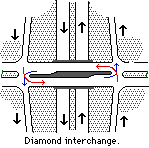Single-point Urban Interchange (SPUI), aka Single-Point Diamond

Pronounced "Spooey", the Single-point Urban Interchange is a relatively new variant of the diamond. Other names for this interchange include "urban interchange" and "single-point diamond." The SPUI's advantages (for appropriate situations) include:
- Compact layout; requires less right-of-way acquisition
- Allows concurrent left turns for greater capacity
- Complex intersection and signal phases may be unfamiliar to drivers
- Multilane ramps or surface streets can lead to very large areas of uncontrolled pavement (used by vehicles in more than one direction)
- Distance between stop bars on surface street creates problems for bicycles, who need more time to clear the area between them
- More free-flow motor vehicle movements (part of what increases the SPUI's capacity) makes it harder for pedestrians to safely cross
- The standard traffic signal timing does not include a phase for pedestrian crossing; again, capacity and safety are at odds
- Vehicle clearance time (where all lights must be red) is longer
- Longer overpasses can require larger bridge girders; retrofits can require raising the bridge or lowering the road underneath
From high enough up, the SPUI resembles a slim classical diamond. However, where a diamond has two ramp intersections at the surface street (one on each side of the freeway), a SPUI's ramps are placed close together to make them effectively part of the same intersection. This allows one traffic signal to control all crossing movements, and enables concurrent opposing left turns, which increases the capacity of the interchange.
Closeup views are provided for the ramp termini of a conventional diamond (top) as well as a SPUI (bottom). Red arrows indicate left-turning exit traffic, and blue arrows indicate left-turning entry traffic. We'll assume traffic is heavy enough to be controlled by signals at the ends of the ramps (the situation where most SPUIs would be employed).
Concurrent opposing left turns
A conventional diamond (see diagram, above) doesn't allow concurrent left turns for substantial traffic, unless cars are allowed to "stack up" between the traffic lights. Opposite left turns leaving the freeway (shown in red) will cross each other; so will the left-turning traffic entering the freeway (shown in blue). Traffic signal taking this into account will generally take longer to cycle through all the phases and give everyone a chance to proceed through the interchange area.

Above is a SPUI and the exit traffic configuration. Just as with an at-grade intersection, opposing left turns can occur at the same time without interfering. Now the interchange can be controlled by one traffic signal assembly with three phases: thru traffic, surface street; left-turning exit traffic (red); left-turning entrance traffic (blue).
SPUI's are new to some areas, and drivers can be unfamiliar with how they work. Often special signals and channeling (using curbs and barriers to guide traffic) are set in place to help. A new SPUI on California 237 in Mountain View generated letters to the newspaper in 1994 asking why the interchange was so strange.
History
The Caltrans newsletter "Corridor Quarterly" attributes the invention of the SPUI to Wallace Hawkes, Director of Transportation Engineering at Greiner, Inc., over 20 years ago. The new SPUI at Monument Boulevard on I-680 in Walnut Creek was a focus of the Spring 1996 issue.
Known as the "granddaddy of the urban interchange," Hawkes cites his design as more efficient and compact than a conventional interchange." "The unique feature is the inverted left turn lane," he explains in the Quarterly. "It allows left turns to be made simultaneously and in a considerably smaller space." An additional space saving feature is the use of a single traffic signal to control the interchange; Conventional interchanges require two or more signals.
There are approximately 60 SPUIs in the United States today. The first one opened in 1974 on SR 60 in Clearwater, Florida.
"Now they're popping up all over the place," said Hawkes.
Thanks to James Lin for posting this information on misc.transport.road.
Stacked Diamond

A variant of the SPUI was considered for the improvement of the North Central Expressway in Dallas, Texas. The Stacked Diamond (shown) is a three-level variation of the four-level Stack interchange. All left-turning ramps meet in a single two-phase signalized intersection; in other words, the two flyover ramp levels are combined into one. There are no turns at the intersection; traffic on each ramp either waits or proceeds straight through.
Like the SPUI, the stacked diamond concentrates left-turning traffic into one intersection. The design origins in the Stack interchange are also apparent. But the role of the ramps — to remove signalized turning traffic from the through roadways, which flow unimpeded — is that of the Volleyball interchange, just in a slightly different form.
"Volleyball SPUI"
I've heard this term mentioned on misc.transport.road, about a three-level SPUI where turning movements are handled on their own level, while thru traffic flows unimpeded. This resembles the stacked diamond (above), but without the wide sweeping ramps.
SPUI treatment for a partial cloverleaf
If volleyball interchanges can be SPUI-fied, so could a four-ramp partial cloverleaf (although I haven't seen a real-life example of this). For a diagram of this, see Oddities.
Inner SPUI with left exits
Interstate 290 in Chicago features a few diamond interchanges with left-hand entrance and exit ramps. The ramp termini form a single intersection at the surface street between I-290's roadways. It works like a SPUI, though the left exits are discouraged nowadays. Other highways that do this include I-244 in Tulsa.
Links
- Interchanges
- Glossary
- Culture: interchanges in movies, computer games, etc.
- Diamond and other 4-ramp designs
- Six-ramp partial cloverleaf
- Cloverleaf
- Trumpet and other 3-way interchanges
- Stack and other heavy-duty 4-way interchanges
- Volleyball: an odd 3-level 4-way treatment
- SPUI: Single-Point Urban Interchange
- Oddities: Some strange or fictional interchanges